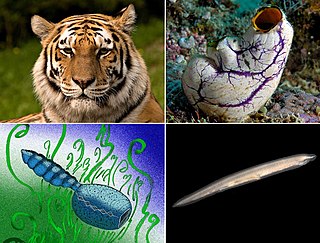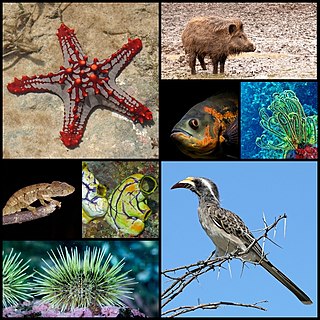
A chordate is an animal of the phylum Chordata. During some period of their life cycle, chordates possess a notochord, a dorsal nerve cord, pharyngeal slits, and a post-anal tail: these four anatomical features define this phylum. Chordates are also bilaterally symmetric, and have a coelom, metameric segmentation, and circulatory system.
The Cambrian Period was the first geological period of the Paleozoic Era, and of the Phanerozoic Eon. The Cambrian lasted 55.6 million years from the end of the preceding Ediacaran Period 541 million years ago (mya) to the beginning of the Ordovician Period 485.4 mya. Its subdivisions, and its base, are somewhat in flux. The period was established by Adam Sedgwick, who named it after Cambria, the Latin name of Wales, where Britain's Cambrian rocks are best exposed. The Cambrian is unique in its unusually high proportion of lagerstätte sedimentary deposits, sites of exceptional preservation where "soft" parts of organisms are preserved as well as their more resistant shells. As a result, our understanding of the Cambrian biology surpasses that of some later periods.

A Global Boundary Stratotype Section and Point (GSSP) is an internationally agreed upon reference point on a stratigraphic section which defines the lower boundary of a stage on the geologic time scale. The effort to define GSSPs is conducted by the International Commission on Stratigraphy, a part of the International Union of Geological Sciences. Most, but not all, GSSPs are based on paleontological changes. Hence GSSPs are usually described in terms of transitions between different faunal stages, though far more faunal stages have been described than GSSPs. The GSSP definition effort commenced in 1977. As of 2020, 75 of the 104 stages that need a GSSP have a ratified GSSP.
The Ordovician is a geologic period and system, the second of six periods of the Paleozoic Era. The Ordovician spans 41.6 million years from the end of the Cambrian Period 485.4 million years ago (Mya) to the start of the Silurian Period 443.8 Mya.

Trilobites are a group of extinct marine artiopodan arthropods that form the class Trilobita. Trilobites form one of the earliest-known groups of arthropods. The first appearance of trilobites in the fossil record defines the base of the Atdabanian stage of the Early Cambrian period, and they flourished throughout the lower Paleozoic before slipping into a long decline, when, during the Devonian, all trilobite orders except the Proetida died out. The last extant trilobites finally disappeared in the mass extinction at the end of the Permian about 252 million years ago. Trilobites were among the most successful of all early animals, existing in oceans for almost 300 million years.

Acritarchs are organic microfossils, known from approximately 1800 million years ago to the present. Their diversity reflects major ecological events such as the appearance of predation and the Cambrian explosion.

Opabinia regalis is an extinct, stem group arthropod found in the Middle Cambrian Burgess Shale Lagerstätte of British Columbia, Canada. It flourished from 505 million years ago to 487 million years ago during the Cambrian Period of the Paleozoic Era. It measured 2-3 inches in length and is presumed to have been a carnivore. Fewer than twenty good specimens have been described; 3 specimens of Opabinia are known from the Greater Phyllopod bed, where they constitute less than 0.1% of the community. Opabinia was a soft-bodied animal, averaging about 5.7 cm in length, and its segmented body had lobes along the sides and a fan-shaped tail. The head shows unusual features: five eyes, a mouth under the head and facing backwards, and a proboscis that probably passed food to the mouth. Opabinia probably lived on the seafloor, using the proboscis to seek out small, soft food.

Charles Doolittle Walcott was an American paleontologist, administrator of the Smithsonian Institution from 1907 to 1927, and geologist. He is famous for his discovery in 1909 of well-preserved fossils, including some of the oldest soft-part imprints, in the Burgess Shale of British Columbia, Canada.
The Cambrian Railways owned 230 miles (370 km) of track over a large area of mid Wales. The system was an amalgamation of a number of railways that were incorporated in 1864, 1865 and 1904. The Cambrian connected with two of the larger railways to give connections to the northwest of England via the London and North Western Railway, and with the Great Western Railway for connections between London and Wales. The Cambrian Railways amalgamated with the Great Western Railway on 1 January 1922 as a result of the Railways Act 1921. The name is continued today in the route known as the Cambrian Line.
The Furongian is the fourth and final epoch and series of the Cambrian. It lasted from 497 to 485.4 million years ago. It succeeds the Miaolingian series of the Cambrian and precedes the Lower Ordovician Tremadocian stage. It is subdivided into three stages: the Paibian, Jiangshanian and the unnamed 10th stage of the Cambrian.

Llandecwyn railway station serves the rural area around Llandecwyn on the estuary of the Afon Dwyryd in Gwynedd, Wales.

Tygwyn railway station is located at a level crossing on the A496 between Harlech and Talsarnau near the estuary of the Afon Dwyryd in Gwynedd, Wales.

Tonfanau railway station is a railway stop that serves Tonfanau in Gwynedd, Wales. The station is located alongside the ruins of the army base it once served and only a couple of occupied buildings can be found within the surrounding area.

The end-Botomian mass extinction event, also known as the late early Cambrian extinctions, refer to two extinction intervals that occurred during Stages 4 and 5 of the Cambrian Period, approximately 513 to 509 million years ago. Estimates for the decline in global diversity over these events range from 50% of marine genera up to 80%. Among the organisms affected by this event were the small shelly fossils, archaeocyathids, trilobites, brachiopods, hyoliths, and mollusks.
The small shelly fauna, small shelly fossils (SSF), or early skeletal fossils (ESF) are mineralized fossils, many only a few millimetres long, with a nearly continuous record from the latest stages of the Ediacaran to the end of the Early Cambrian Period. They are very diverse, and there is no formal definition of "small shelly fauna" or "small shelly fossils". Almost all are from earlier rocks than more familiar fossils such as trilobites. Since most SSFs were preserved by being covered quickly with phosphate and this method of preservation is mainly limited to the Late Ediacaran and Early Cambrian periods, the animals that made them may actually have arisen earlier and persisted after this time span.
The Cambrian explosion or Cambrian radiation was an event approximately 541 million years ago in the Cambrian period when practically all major animal phyla started appearing in the fossil record. It lasted for about 13 – 25 million years and resulted in the divergence of most modern metazoan phyla. The event was accompanied by major diversification of other organisms.

Deuterostomes constitute a superphylum of animals. It is a sister clade of Protostomia, with which it forms the Nephrozoa clade.

An arthropod is an invertebrate animal having an exoskeleton, a segmented body, and paired jointed appendages. Arthropods form the phylum Euarthropoda, which includes insects, arachnids, myriapods, and crustaceans. The term Arthropoda as originally proposed refers to a proposed grouping of Euarthropods and the phylum Onychophora.

The East Antarctic Shield or Craton is a cratonic rock body that covers 10.2 million square kilometers or roughly 73% of the continent of Antarctica. The shield is almost entirely buried by the East Antarctic Ice Sheet that has an average thickness of 2200 meters but reaches up to 4700 meters in some locations. East Antarctica is separated from West Antarctica by the 100–300 kilometer wide Transantarctic Mountains, which span nearly 3,500 kilometers from the Weddell Sea to the Ross Sea. The East Antarctic Shield is then divided into an extensive central craton that occupies most of the continental interior and various other marginal cratons that are exposed along the coast.

Euperipatoides kanangrensis is a species of velvet worm of the Peripatopsidae family, described in 1996 from specimens collected in Kanangra-Boyd National Park, New South Wales. It is endemic to Australia. The embryonic development of Euperipatoideskanangrensis has been described. This species is used as model organism for the last common ancestor of the Panarthropoda. It resembles fossil Cambrian lobopodians.













